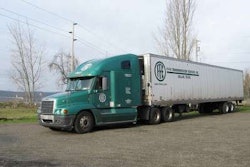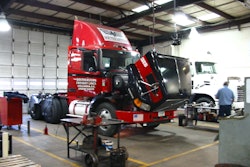
A wary confidence prevailed among senior transportation executives and leading technology providers at this year’s ALK Transportation Technology Summit in Princeton, N.J. Participants at the symposium focused less on economic issues and more on familiar trucking challenges – driver turnover, regulatory demands and operational efficiency. ALK says attendance at the April 27-29 summit was the highest in the event’s six-year history.
Keynote speaker Paul Will, vice chairman and chief financial officer for Celadon Group, the Indianapolis-based truckload carrier operating 2,900 tractors, said manufacturing is picking up, consumer spending is recovering, and projections call for continued increases into 2011. While some signs are positive, Will pointed out economic activity is substantially below its pre-recession levels. “We have a new baseline,” he said. “We’re growing from that.” However, the commercial real estate market is still falling. “Nonresidential construction continues in a steep decline that may not bottom out until sometime next year, and the turnaround, such as it is, has not come in time to save some carriers.”
Tim Bickmore, executive vice president at TransCore, reported that “the spot trucking market has turned strongly in favor of carriers this year.” Bickmore, general manager of TransCore’s Commercial Business Services Group, said the spot market accounts for 15 to 20 percent of the entire trucking market. At last year’s summit, Bickmore reported that the load-to-truck ratio had fallen to .6 loads for each available truck – close to two trucks for every available load. This year, TransCore has seen the load-to-truck ratio swing to five loads for each available truck, he said.
Dr. Alain Kornhauser, founder and chairman of ALK Technologies, said ALK is working on accurate dock-to-dock routing that avoid traffic delays by using both real-time and historic traffic data, including predictable slowdowns on specific routes. “There are many ways to get from A to B,” he said. “Now we’re trying to figure out how long it’s going to take you to get from A to B.”
Cindy Nelson, vice president of marketing and business development for EBE Technologies, described an automated toll management solution from EBE and ALK that links precise toll costs with data from trucking operations software. She said fleets can verify that trucks actually travelled the roads where tolls were charged and that the amounts charged are correct.
Co-presenter John Hazenfield offered a tolls case study on Distribution Technologies Inc., a liquid bulk carrier operating 500 trucks. Hazenfield is executive vice president and chief information officer for DistTech, which uses toll facilities from coast to coast and pays between $60,000 and $70,000 per month in tolls. The new system has helped DistTech successfully manage those tolls. “PC Miler Tolls Auditor and Manager are tremendous assets we’ve added to the company,” he said. “We have uncovered multiple lanes where we were underbilling the shipper.”
In another tolls-related presentation, Mike Gabbei, CIO for Celadon Group, said that using PC Miler Tolls’ new toll plaza designations in a test group of 180 trucks was working well. “Working with ALK and Manhattan Associates, we expect to put toll transponders on the entire fleet,” he said. “Along with the transponder discounts, we expect to see a $750,000 savings.”
David McKinney, vice president of professional services for TMW Systems, said empty miles can be the difference between profit and loss. “But deadheading must be addressed from a big-picture perspective, factoring in such things as operational requirements, regulatory restrictions and the ratio of equipment to available loads in any geographic area.”
Co-presenter Murry Fitzer, chief executive officer of Florilli Transportation, a refrigerated truckload carrier, said Florilli uses TMW’s planning optimization. “I can check the deadhead report daily,” he said. “I get insight that’s better than looking at a weekly report.”
Tom McLeod, president and CDO of McLeod Software, and Robert Howard, president of RWH Trucking and Logistics Inc., discussed the growing application of SaaS to third-party logistics and freight brokerage operations. McLeod said carriers are finding themselves in the brokerage business as “a defensive move because larger players are moving in and taking over much freight management,” he said. “They’re changing the game.” Hosted software makes sense for these companies because it can be deployed rapidly and easily scaled for a given operation.
Mike Spahis, general manager of logistics for Commercial Metals Co., described how they have used PC Miler Web Services to help bring order to trucking services that had been dispersed across 170 locations, including 97 that operated a total of 600 company trucks. “We took control of an unorganized system,” Spahis said. “We were paying drivers hourly or on hub miles. PC Miler streamlines this and provides a trusted standard.”
The summit also featured three roundtable discussions. The Truckload Roundtable was led by Kevin Burch, president and CEO of Jet Express and immediate past chairman of the Truckload Carriers Association, who focused on a renewed driver shortage. The average age of drivers in the industry is 47, he noted, and the average at his own company is 58. “It’s time to get recruitment and retention efforts back in gear,” Burch said. “There is a ‘perfect storm’ brewing again.” The LTL Roundtable was led by Steve O’Kane, president of carrier A. Duie Pyle. The Shipper, Private Fleet & 3PL Roundtable was chaired by Robert Voltman, president and CEO of TIA, the Transportation Intermediaries Association.
Mike Bodden, ALK’s chief technology officer, outlined roadmaps for ALK’s core routing and mileage product, PC Miler, and its navigation offering CoPilot Live. Bodden said that PC Miler 24 includes enhanced 53-foot/twin trailer routing, publicly accessible lots for LCVs (Long Combination Vehicles) and new least cost routing functionality.
Michael Kornhauser, ALK’s vice president and managing director of CoPilot Solutions, said that through mobile communications systems, fleets can send routes from the back office to the CoPilot Truck application in the cab, and CoPilot Truck can send out-of-route warnings back.
ALK’s Dan Popkin, vice president of CoPilot Sales, led a panel discussion of truck-specific GPS navigation. The panelists were Kush Parikh, senior vice president of business development and sales for INRIX Inc.; Kendra Adams, executive director of the New York Motor Truck Association; and Douglas Frank, vice president of professional services for Cadec Global Inc. Adams described New York State’s problem with large trucks that hit low bridges on truck-restricted roadways. This problem, attributed to truck drivers using GPS navigation devices designed for cars, is a serious safety issue.
Other presenters addressed such topics as CSA 2010, the new safety scoring system from the Federal Motor Carrier Safety Administration; the promise and perils of cloud computing; fleet management dashboards; and cost analysis.
“As usual, the 2010 ALK summit delivered on all aspects – knowledge, future plans for ALK and the industry, great featured speakers and an excellent networking event,” said John Reed, CIO of Aim Dedicated Logistics. “The summit takes away the normal ‘hard vendor sell’ and allows the attendees access to new vendor technologies without the pressure of filling a sales quota. It is the only industry event I attend where the focus is on the exchange of ideas and not on new sales.”
The ALK Summit was “an executive networking session with very timely and relevant informational presentations, many of which will be useful to me immediately,” said Jim Mullen, general manager of Transfreight LLC. “I will return next year.”












